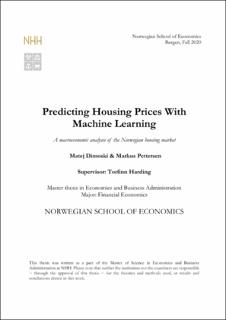Predicting housing prices with machine learning : a macroeconomic analysis of the Norwegian housing market
Master thesis
Permanent lenke
https://hdl.handle.net/11250/2734788Utgivelsesdato
2020Metadata
Vis full innførselSamlinger
- Master Thesis [4372]
Sammendrag
This thesis explores the applicability of machine learning in macroeconomic housing price
predictions in Norway. We apply three machine learning models Elastic Net, Random Forest and
Neural Network on historical time-time series data and predict quarterly and yearly growth rates
between 2013 and 2019. The performance is evaluated upon predictions from Norges Bank, DNB
and SSB.
Our results indicate that machine learning can produce predictions with the same accuracy as
professional institutions. Among the machine learning models, Elastic Net produces the most
accurate quarterly predictions. Compared to Norges Bank, Elastic Net’s predictions are more
accurate in 29,6% of the quarters, but less precise in the overall evaluation. Large deviations during
2018 and 2019 are decisive for the lacking performance, after new mortgage regulations were
introduced from Finanstilsynet. Random Forest predicts the most accurate yearly predictions but
is outperformed by Norges Bank. Still, Random Forest surpasses both DNB and SSB throughout
the evaluation process.
The thesis contributes to the existing literature in several aspects. First, by outperforming housing
experts, we challenge traditional macroeconomic approaches in the choice of predictive models.
Second, our results indicate that linear models are more suited in shorter time spans, while
nonlinear models perform better over longer horizons. Third, the machine learning models have
identified household debt as the most influential variable to determine the housing prices in
Norway. Overall, we believe machine learning approaches could become valuable in further
academic and professional macroeconomic research.
Keywords - Machine Learning, Prediction, Forecasting, Housing Market, Macroeconomics
